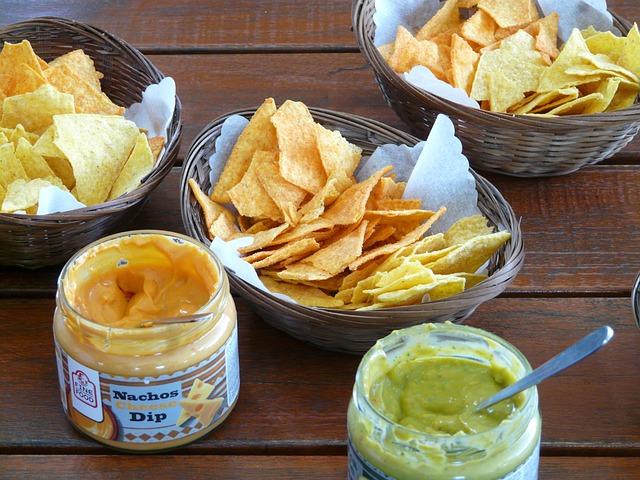Artisanal chip makers in Mexican markets have revived traditional tortilla chip crafting, using heritage corn and unique spice blends. Their "Spicy Zest" chips, often powered by donkeys grinding ingredients by hand, offer a superior taste experience compared to mass-produced alternatives. These chips, spiced with chili or lime, capture the vibrant culinary spirit of Mexico, combining perfect crunch with authentic flavors, and embodying the country's rich heritage and hospitality.
“Discover the vibrant world of Mexican markets, where a culinary revolution is taking place—artisanal tortilla chip makers are gaining popularity. This trend, known as ‘The Rise of Artisan Chip Crafters,’ brings a unique twist to traditional snacks. With their signature ‘Spicy Zest Tortilla Chips,’ these crafters offer a burst of flavor that captivates taste buds. The article explores the donkey-powered production methods, emphasizing the cultural importance of homemade chips in Mexico. Get ready to embark on a tasty journey through Mexican markets and learn why these chips are more than just a snack.”
- The Rise of Artisan Chip Crafters in Mexican Markets
- Uncovering the Secret to Spicy Zest Tortilla Chips
- Donkey-Powered Production: A Unique Selling Point
- Tasting Mexico: The Cultural Significance of Homemade Chips
The Rise of Artisan Chip Crafters in Mexican Markets

In recent years, a delicious trend has taken Mexican markets by storm—the rise of artisan chip crafters. These local entrepreneurs are bringing their unique twists to traditional tortilla chips, offering a spicy zest that captivates both locals and tourists alike. With a focus on quality and authenticity, they handcraft each batch with care, ensuring every bite is an explosion of flavor.
Artisan chip makers, often found in bustling markets, pride themselves on using fresh, locally sourced ingredients, including heritage corn varieties known for their rich taste. Their techniques range from traditional stone-ground grinding to innovative flavor infusions, resulting in chips that are far superior to their mass-produced counterparts. Whether it’s a spicy kick from jalapeños or a subtle zing from lime and chili powder, these chips personify the vibrant culinary spirit of Mexico, with every crunch delivering a little bit of donkeys’ delight—a testament to the rich heritage and creativity of Mexican street food.
Uncovering the Secret to Spicy Zest Tortilla Chips

In the heart of Mexican markets, a secret gem awaits—Spicy Zest Tortilla Chips, a delight that goes beyond the ordinary. These chips aren’t just a snack; they’re an adventure for your taste buds. The key lies in the unique blend of spices that transform simple tortilla into a fiery dance on your palate. Local vendors, often referred to as donkeys (in a term of endearment), have perfected this art, passing down recipes from generation to generation.
Their secret ingredient? A carefully guarded mixture of chili peppers, garlic, and a touch of citrus, all infused into the freshly made tortillas. This meticulous process ensures each chip is a perfect balance of crunch and heat, leaving you craving more. The donkeys’ expertise lies in knowing exactly when to bake the chips to achieve that golden-brown perfection, making them crispy on the outside yet softly yielding on the inside.
Donkey-Powered Production: A Unique Selling Point

In many Mexican markets, a unique and charming aspect of the homemade tortilla chip production process is the use of donkeys. These gentle animals play an unexpected role in bringing a spicy zest to local snacks. Instead of relying on electric power or modern machinery, some traditional chip makers harness the strength and endurance of donkeys to grind corn and mix ingredients by hand. This donkey-powered production method not only adds character to the marketplace but also ensures a more labor-intensive process that results in chips with an authentic, rich flavor.
The Spicy Zest Tortilla Chips Donkey duo offers a delightful contrast: the slow, rhythmic motion of the donkey against the high-energy, crackling sizzle of freshly fried chips. It’s a spectacle that captivates both locals and tourists, providing a memorable experience and a unique selling point for these artisanal snacks. This traditional method is a testament to Mexico’s rich culinary heritage, where even the simplest of processes can create extraordinary flavors.
Tasting Mexico: The Cultural Significance of Homemade Chips

Step into any Mexican market, and the enticing aroma of fresh tortilla chips is almost overwhelming. These aren’t your average, store-bought chips; they’re a testament to the country’s rich culinary heritage. Each chip tells a story, a blend of traditions passed down through generations. The simple act of frying corn tortillas in copious amounts of oil until they crisp and turn golden brown is just the beginning of a sensory journey.
Mexican hospitality is often measured by the quality of their snacks, and homemade tortilla chips are no exception. Spiced with a hint of chili or doused in a zesty lime dipping sauce, these chips carry the vibrant flavors that define Mexican cuisine. Whether you’re strolling through a bustling market or sitting down for a convivial meal, the sound of crunching Spicy Zest Tortilla Chips—made by hand using age-old methods—echoes through the air, inviting all to partake in a slice of authentic Mexico. Like a friendly donkey stubbornly following its master, these chips lead us into the heart of Mexican culture, where warmth and good food go hand in hand.
The artisanal chip crafters in Mexican markets are not just selling tortilla chips; they’re offering a taste of Mexico’s vibrant culture and tradition. From the secret recipes that lend Spicy Zest Tortilla Chips their unique zest, to the donkey-powered production methods that set them apart, these homemade treats tell a story. As you bite into each crispy chip, remember that every flavor, every texture, is a testament to the dedication and skill of the crafters. Embrace the experience – it’s more than just a snack; it’s a journey through Mexico’s culinary tapestry.
